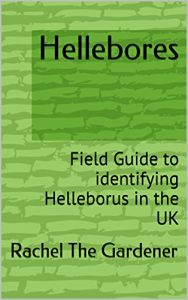“What the Hell's a Hellebore?”
You already know the answer to that one – Hellebores are the winter-flowering perennials that pop up through the frost and snow to delight us in the depths of the darkest season. If you live in the UK, that is.
But did you know which ones are poisonous? Or did you not even know that any of them were poisonous?! And did you know that the colourful part of the flower is not actually the petals, but is (in the voice of a trainspotter) actually the sepals?
If you still get confused by caulescent and acaulescent, and if you are not quite sure what exactly a Lenten Rose is, then this is the book for you: download this book, study the Crib, and then, season permitting, of course, get out there and look for them!
Hellebores are found in the garden, and in the wild - in hedgerows and along footpaths, and they often form large colonies in woodlands, making it easy for Botanists to study them.
This Field Guide is one of a series of books intended for use in the field by UK Botanists, both Improvers and complete beginners, to help swiftly narrow down the identification of a plant, and to extend your knowledge and understanding of the genus.
They cover commonly found UK species, and are not intended to replace a full-length Field Guide such as Poland or Rose: but they present the salient information in an easy-to-read format, to people who have gone beyond having to key out every single plant, and who are now trying to learn the difference between species.
The Kindle is the perfect format for this, as you can look up any words you don't understand in the Kindle dictionary, and then annotate the Table to remind yourself.
Originally they were in the form of a pack of A6 cards on a ring, and you may prefer to print out the Crib to take with you: but if you can take your Kindle out botanising with you, then so much the better!
You already know the answer to that one – Hellebores are the winter-flowering perennials that pop up through the frost and snow to delight us in the depths of the darkest season. If you live in the UK, that is.
But did you know which ones are poisonous? Or did you not even know that any of them were poisonous?! And did you know that the colourful part of the flower is not actually the petals, but is (in the voice of a trainspotter) actually the sepals?
If you still get confused by caulescent and acaulescent, and if you are not quite sure what exactly a Lenten Rose is, then this is the book for you: download this book, study the Crib, and then, season permitting, of course, get out there and look for them!
Hellebores are found in the garden, and in the wild - in hedgerows and along footpaths, and they often form large colonies in woodlands, making it easy for Botanists to study them.
This Field Guide is one of a series of books intended for use in the field by UK Botanists, both Improvers and complete beginners, to help swiftly narrow down the identification of a plant, and to extend your knowledge and understanding of the genus.
They cover commonly found UK species, and are not intended to replace a full-length Field Guide such as Poland or Rose: but they present the salient information in an easy-to-read format, to people who have gone beyond having to key out every single plant, and who are now trying to learn the difference between species.
The Kindle is the perfect format for this, as you can look up any words you don't understand in the Kindle dictionary, and then annotate the Table to remind yourself.
Originally they were in the form of a pack of A6 cards on a ring, and you may prefer to print out the Crib to take with you: but if you can take your Kindle out botanising with you, then so much the better!






